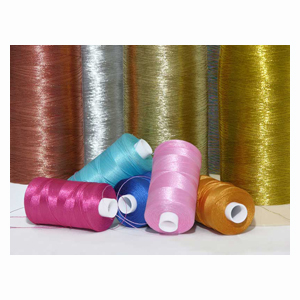 To really understand the evolution of the Machine Embroidery Threads we use today, it is necessary to look back at the development of machine embroidery in general.
To really understand the evolution of the Machine Embroidery Threads we use today, it is necessary to look back at the development of machine embroidery in general.
You probably all have a few hand embroidered pieces stashed away – table covers, runners, mats etc worked by hand from many years ago (you know the sort – too nice to dispose of but they live in a drawer!) Of course they were all worked in 100% cotton, very similar to the 6 strand and perle that are still used today. The thread had to be smooth and tangle free to pull through all the fine cotton fabrics.
Then embroidery using machines began to happen in industry. Perhaps one of the most common examples being embroidered handkerchiefs – initials for men, flowers for women. Again it was always 100% cotton that was used. It was mercerised I.e. the thread had been ‘polished’ to remove the natural hairiness of cotton which left the thread with a soft sheen. The sheen of the embroidery contrasted with the natural mattness of the fabric.
It was only years later that synthetic threads were used. Their innate dyeing properties meant that the sheen could be enhanced to a super gloss finish. The machine manufacturers then recognised the demand for dedicated domestic embroidery machines and computerised machine embroidery ‘took off’.
Exactly the same principles from years ago applied – smooth, tangle free thread was essential – in fact more so than ever as the machines run far faster than anyone is able to work with a needle. This of course results in heat building up in the eye of the needle at the point of stitching so the new threads had to be capable of resisting this heat/friction but still have a gloss appearance in the finished piece.
At this point we should also address free hand machine embroidery as well as computerised work. Although a computerised machine completes many stitches per minute, the stress of free hand work is equally as onerous on the thread so the requirements are just as critical.
As any machine embroiderer knows the criteria is smooth running, gloss finish and good pattern fill.
 Polyester or Rayon Thread
Polyester or Rayon Thread
The choice of threads is huge but they are essentially all variations on two types – polyester and rayon. There is a slight difference. Rayon has a slightly higher sheen but is weaker than polyester which in turn is stronger with not quite as high a gloss-finish. Rayon is often referred to as Art Silk – this is historic. It was hailed, many years ago, as being the cheaper alternative to Pure Silk. These days, thankfully, we have Pure Silk, Rayon & Polyester all freely available in the market place.
However 40s Machine Embroidery Thread is a good, basic, problem free thread to use. The most pertinent reason for this is that it goes through the manufacturing processes of twisting, winding and finishing just like a 100% natural thread. It therefore has the same sewability of a traditionally produced thread so is tangle free and has no ’slippage’. This eliminates the need to start altering tensions on the machine. Its plies are evenly twisted to ensure that for such a fine thread it is still relatively strong.
All this means that it is ‘high tech’ enough to cope with the speed of computerised machines as well as being capable of the most complex free machine techniques. It can also be relied on to give good coverage and pattern fill.
We recommend it to both complete beginners as well as experts who want to concentrate on the intricacy of design rather than be distracted by any problems with the machine.
Perhaps the best description of this thread is ‘a good all rounder’. To see the full shade range take a look at the Machine Embroidery Thread section of the site.
Shop Machine Embroidery Thread Here.
You May Also Be Interested In
HT Poly Machine Embroidery Backing Thread. A super example of an industrial thread fulfilling creative needs. View the article here.



